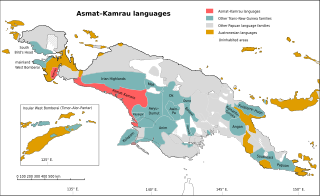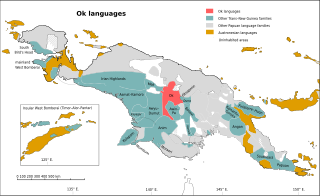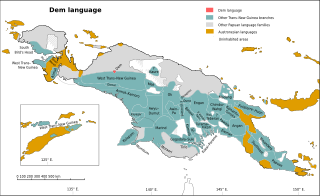
Dutch New Guinea or Netherlands New Guinea was the western half of the island of New Guinea that was a part of the Dutch East Indies until 1949, later an overseas territory of the Kingdom of the Netherlands from 1949 to 1962. It contained what are now Indonesia's six easternmost provinces, Central Papua, Highland Papua, Papua, South Papua, Southwest Papua, and West Papua, which were administered as a single province prior to 2003 under the name Irian Jaya, and now comprise the Papua region of the country.
The Sko or Skou languages are a small language family spoken by about 7000 people, mainly along the Vanimo coast of Sandaun Province in Papua New Guinea, with a few being inland from this area and at least one just across the border in the Indonesian province of Papua.

Puncak Trikora is a 4,730 or 4,750-metre-high (15,584 ft) mountain in the Highland Papua province of Indonesia on New Guinea. It lies in the eastern part of the Sudirman (Nassau) Range of the Maoke Mountains.
The Lakes Plain languages are a family of Papuan languages, spoken in the Lakes Plain of Indonesian New Guinea. They are notable for being heavily tonal and for their lack of nasal consonants.
Aghu, or Central Awyu, is a Papuan language of South Papua, Indonesia. It may actually be two languages, depending on one's criteria for a 'language'. The two varieties are: Mappi River Awyu (Aghu) and Pasue River Awyu.

Ekari is a Trans–New Guinea language spoken by about 100,000 people in the Paniai lakes region of the Indonesian province of Central Papua, including the villages of Enarotali, Mapia and Moanemani. This makes it the second-most populous Papuan language in Indonesian New Guinea after Western Dani. Language use is vigorous. Documentation is quite limited.

The Asmat – Kamrau Bay languages are a family of a dozen Trans–New Guinea languages spoken by the Asmat and related peoples in southern Western New Guinea. They are believed to be a recent expansion along the south coast, as they are all closely related, and there is little differentiation in their pronouns.
The Pauwasi languages are a likely family of Papuan languages, mostly in Indonesia. The subfamilies are at best only distantly related. The best described Pauwasi language is Karkar, across the border in Papua New Guinea. They are spoken around the headwaters of the Pauwasi River in the Indonesian-PNG border region.

The Kaure–Kosare or Nawa River languages are a small family spoken along the Nawa River in West Papua, near the northern border with Papua New Guinea. The languages are Kaure and Kosare.

The South Bird's Head or South Doberai languages are three families of Papuan languages. They form part of the Trans–New Guinea languages in the classifications of Malcolm Ross (2005) and Timothy Usher (2020), though Pawley and Hammarström (2018) do not consider them to be part of Trans–New Guinea. However, according to Dryer (2022), based on a preliminary quantitative analysis of data from the ASJP database, South Bird's Head languages are likely to be a subgroup of Trans–New Guinea.
The Dani or Baliem Valley languages are a family of clearly related Trans–New Guinea languages spoken by the Dani and related peoples in the Baliem Valley in the Highland Papua, Indonesia. Foley (2003) considers their Trans–New Guinea language group status to be established. They may be most closely related to the languages of Paniai Lakes, but this is not yet clear. Capell (1962) posited that their closest relatives were the Kwerba languages, which Ross (2005) rejects.
The Paniai Lakes languages, also known as the Wissel Lakes or Wissel Lakes – Kemandoga River, are a small family of closely related Trans–New Guinea languages spoken in the Paniai Lakes region of the highlands of Western New Guinea in the Paniai Lakes region of Papua. Foley (2003) considers their Trans–New Guinea status to be established.

The Ok languages are a family of about a dozen related Trans–New Guinea languages spoken in a contiguous area of eastern Irian Jaya and western Papua New Guinea. The most numerous language is Ngalum, with some 20,000 speakers; the best known is probably Telefol.
The Demta–Sentani languages form a language family of coastal Indonesian Papua near the Papua New Guinea border.
The Wapoga River is a river in northern New Guinea, Central Papua, Indonesia. It is a tributary of the Warenai River. The Wapoga River basin and surrounding mountains were surveyed by a team of scientists organized by Conservation International in 1998. The rainbowfish Glossolepis leggetti and Melanotaenia rubripinnis are only known from this river system.

Puncak Jaya or Carstensz Pyramid on the island of New Guinea, with an elevation of 4,884 m (16,024 ft), is the highest mountain peak of an island on Earth, and the highest peak in Indonesia. The mountain is located in the Sudirman Range of the highlands of Mimika Regency, Central Papua, Indonesia. Puncak Jaya is ranked 5th in the world by topographic isolation.

Dem is a divergent Papuan language of West New Guinea. Although Palmer (2018) leaves it unclassified, it was tentatively included in the Trans–New Guinea family in the classification of Malcolm Ross (2005), and Timothy Usher ties it most closely to Amung.

Kaure is a Papuan language of West Papua. It is spoken in the villages of Lereh, Harna, Wes, Masta, and Aurina.
Kayagar is a Papuan language spoken in South Papua. Wiyagar is spoken in Sigare Village, Kaitok Village and Yame Village in Assue District, Mappi Regency, While Kaigar is spoken in Amagais Village, Der Koumur District, Asmat Regency.

Johannes Cornelis Anceaux was a Dutch linguist and anthropologist known for his extensive work on Papuan and Austronesian languages.










